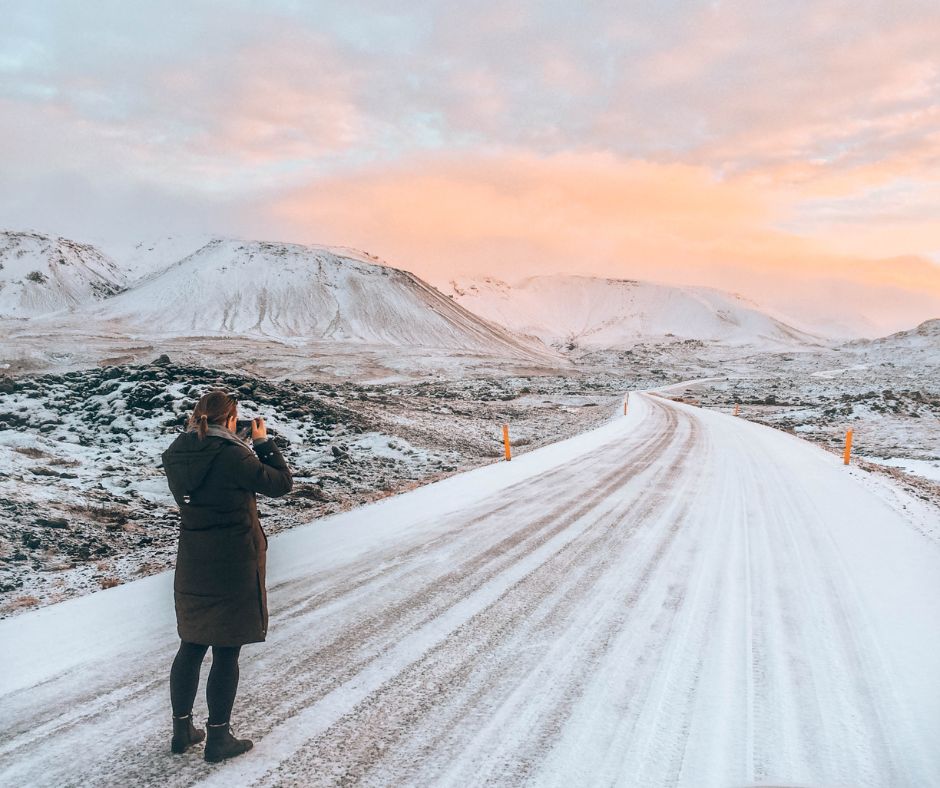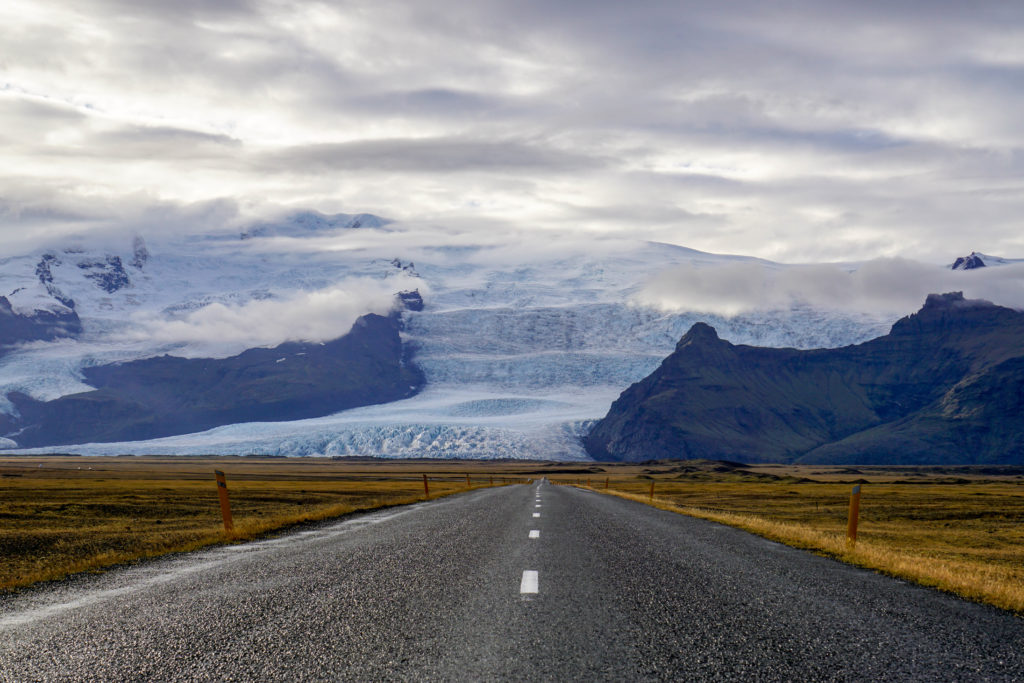Are you ready for an unforgettable adventure this January in Iceland?
Featuring dramatic snowy vistas, northern lights, and crisp, frosty air, January offers you the chance to witness Iceland in all of its winter glory.
In my opinion, winter is best enjoyed soaking in natural hot springs while everything around you is covered in snow.
But, before you book your tickets, there are a few things you need to know in order to plan the best January trip ever.
Follow me into the land of ice and intrigue…
Table of Contents
- Is January a Good Time to Visit Iceland?
- Daylight Hours in Iceland in January
- Iceland in January: Northern Lights
- Iceland’s Weather in January
- What To Wear in Iceland in January
- Sightseeing Availability
- Driving in Iceland in January
- January Festivals + Events
- Things To Do In Iceland In January
Is January a Good Time to Visit Iceland?

If you’re anything like me and love winter, snow, and the magical beauty of incredible landscapes draped in white, then yes friends, visiting Iceland in January is truly special.
Northern lights: With longer nights, this month offers a fantastic opportunity for hunting the Northern Lights in January.
Off-season: January in Iceland is still considered low season, which means you could save on flights and hotels. This also means fewer tourists, so don’t worry too much about having to Photoshop people out of your beautiful scenic photographs! 😉
Winter tours: January is a great time to book seasonal tours that are only available in the winter!
Daylight Hours in Iceland in January
When it comes to planning your days in Iceland, the number one thing you need to pay close attention to is the daylight hours.
The good news is that we’re just coming off the winter solstice, so the days are becoming longer, but it’s still one of the darkest times of the year.
The daylight hours in Iceland in January range from approximately 4 hours to begin with and increase to about 7 hours of daylight by the end of the month.
Iceland in January: Northern Lights
As the Northern Lights are a must-see experience on most visitors’ bucket lists, tourists often envision visiting Iceland with this incredible natural light show as their backdrop.
Seeing as it’s still pretty dark, chances are good that you’ll get to experience the aurora borealis in Iceland in January.
Be sure to keep an eye on weather conditions and remember that cloudy weather can affect visibility!
READ MORE: How To See The Northern Lights In Iceland: Best Viewing Spots, When To Go And MORE
Iceland’s Weather in January

Iceland is a land of extremes and the weather in Iceland in January is no different.
It’s still winter and one of the coldest months of the year so you can expect a lot of snow, wind, and sometimes even rain.
Temperatures In Iceland In January
If you’re traveling to Iceland in January, temperatures range from -2 to 4 degrees Celsius (28 – 39 degrees Fahrenheit). While it doesn’t seem all that cold, the wind and rain definitely add to the chill factor. 🥶
What To Wear in Iceland in January
If you aren’t used to cold climates, you’ll need to pay close attention to what you pack.
It’s totally worth investing in high-quality gear that’ll keep you warm, dry, and comfortable.
Your outerwear needs to be water and windproof. You’ll also want to layer up with thermal base layers, legging wool socks, and various long-sleeved tops.
I’m going to assume you came to Iceland to view the natural attractions, and the terrains can be rugged, so I’d recommend investing in a good pair of hiking boots in the winter – you’re going to need them!
Snow + wet = VERY slippery surfaces.
Therefore, one of the most important items you need to pack is crampons or Yaktrax. These are placed at the bottom of your shoes and they grip the ice, making it much easier to walk around places like waterfalls and many of the main attractions.
Even if you plan on spending most of your time in Reykjavík, those sidewalks get pretty darn slippery. If you don’t want to end up looking like a newborn deer trying to walk, or worse, you have to bring them along.
Want to learn more about exactly what you should wear in January to stay toasty warm and READY for adventure?
Download my complete Packing Guide for FREE! You’ll get seasonal information, gear recommendations, AND checklists so you don’t forget anything!
Sightseeing Availability In January
Even though there’s a lot of snow, many of the popular destinations are still accessible.
Reykjavík, Golden Circle, and Ring Road: These areas are popular and the roads are maintained quite well, making them safe and accessible.
South Iceland: Waterfalls, glaciers, and the very popular Jökulsárlón Glacier Lagoon and geothermal pools are still easily accessible in January.
Highlands and interior: If you want to hike Þórsmörk (Thórsmörk) or visit Landmannalaugar Nature Reserve, you’re going to have to wait for summer (from mid-June to mid-September). These are definitely not accessible now.
Move on. Look away. Seriously – don’t even try!
Westfjords: Bear in mind that the Westfjords get a lot more snow and I don’t recommend this for inexperienced drivers. There is heavy snowfall in January and road conditions are not great. Mountain passes can be closed. I’d rather make the most of exploring all the other places I can actually access.
Driving in Iceland in January
Now, I know you may think you’ve experienced driving in tough conditions, but take it from me – a girl from the Midwest who’s used to driving in the snow – I had no idea what I was in for with Icelandic winters!
It’s very challenging.
Road conditions change FAST! The roads can be slippery, there are snow drifts and some roads are not cleared or maintained very well.
To keep up with these changes I highly recommend visiting Road.is. They update the conditions daily so you really want to check before heading out for the day.
If you’re renting a vehicle, I 100% recommend renting a 4-wheel drive if you’re going to be driving in Iceland in January. It’s by far the safest option for this season.
If you’d like a few more tips check out the video I made on winter driving in Iceland. 👇🏼
January Festivals + Events
There are a few unique festivals and events happening in and around Iceland and Reykjavík in January.
Þrettándinn: Are you someone who keeps Christmas decorations up until March because you’re not sure when to take them down? Well, here they know. January 6th marks the official end of Christmas in Iceland.
If you’re familiar with the Yule Lads story, then you’ll know that this is the date when the final Yule Lad returns home to the highlands.
Þorrablót: This celebration runs from mid-January to mid-February with its roots in Nordic history and showcases traditional Icelandic foods. In short, Þorrablót is a rotten food festival.
Yup, you heard right!
You’ll see lots of interesting or rotten foods sold and eaten in Iceland, so if you’re brave, you can sample some yourself. Things like sheepshead and sour ram testicles, I mean, seriously, what’s not to like?!
The locals seem to love it, actually, they go nuts for it! 😜
Lava Show Reykjavík: When you’re in the land of fire and ice, it would only make sense to add some fire to your icy January experience. The Lava Show Reykjavík is the world’s only live lava show! Watch superheated lava from the 1918 Katla eruption as it flows into the showroom while the host entertains the audience by manipulating the molten rock. It’s an incredibly unique educational experience during your Iceland trip in January.
Things To Do In Iceland In January
If you’re traveling to Iceland in January, there are loads of tours available. Whatever you do, don’t forget to pack your camera!
Ice caves and Glacier hikes: These are still safe to enter in January. If you visit Skaftafell National Park in southeast Iceland, you can experience the blue ice caves and walk on the Vatnajökull glacier.
Lagoons: Whether it’s the Forest, Blue, or Secret Lagoon, there’s nothing quite like sitting in natural geothermal waters, looking out at a winter landscape. If you’re not sure which one to go to, I put together a Top 10 Blue Lagoon Alternatives that won’t disappoint. Or if you want to see what all the hype is about, you could visit The Blue Lagoon itself!
Whale watching: This is always a favorite activity in the winter months, if you’ve ever seen a minke or humpback whale live, it never gets old. Definitely one of the top things to do in Iceland in January.
Snorkeling in Silfra: Explore one of the best snorkeling areas in Iceland, and swim between the North American and Eurasian tectonic plates – in winter! It’s totally doable, but be warned, it’s cold!
Food tours: One of the best parts about visiting another country is trying its cuisine. If you’re unsure where to begin, there are many food tours on offer in Reykjavík.
My all-time favorite is the Reykjavík Food Walk!
It can be difficult to find practical information when planning your trip. I still remember when I was first planning my honeymoon in Iceland and had to scour the internet for HOURS trying to find reliable info.
➡️That’s why I created these Iceland Guidebooks + Maps that cover everything from must-see attractions to hidden gems nobody talks about and even things like parking fees, where to shop for souvenirs, and more.
You also get a digital map with over 500 pinned locations!
So there you have it!
January in Iceland is for you if you’re a winter enthusiast who craves the crisp air on your face, the crunch of fresh snow beneath your feet, the splendor of the Northern Lights across the sky, and so much more!
Happy Planning,

Pin it for later! 👇🏾








